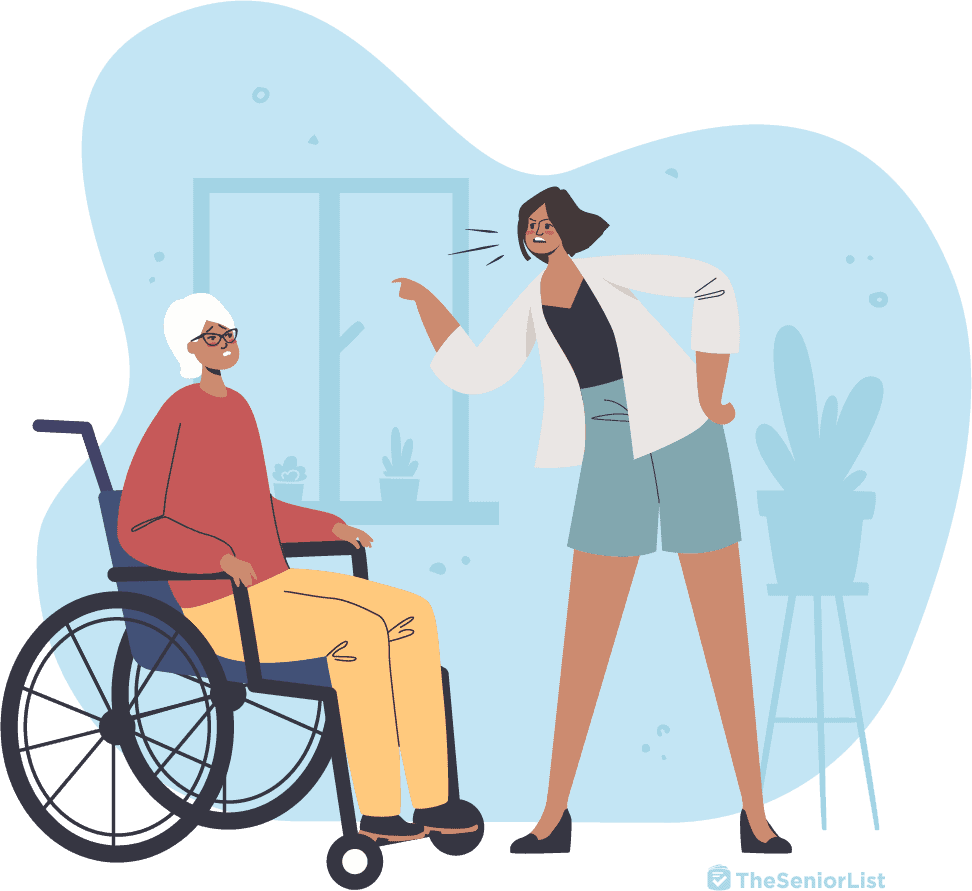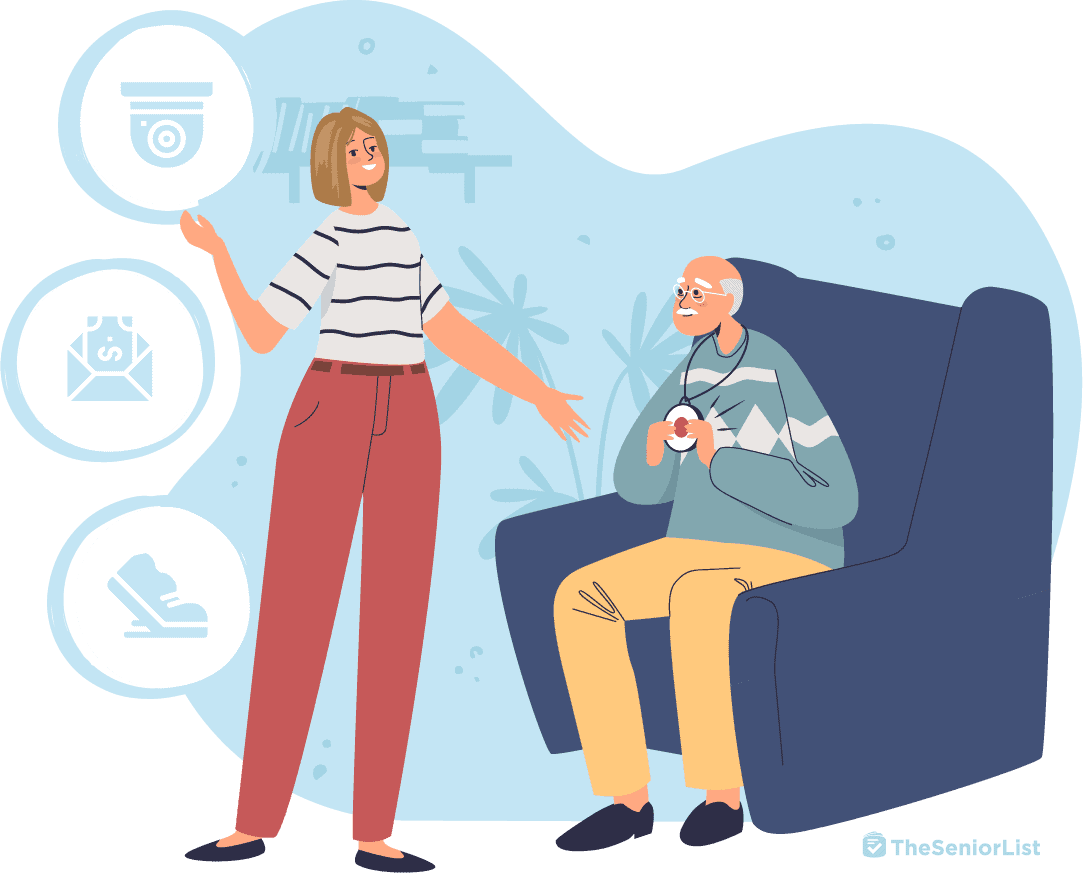What Is Elder Abuse?
Elder abuse is a single or repeated act — or even a failure to act — that causes risk or harm to an older adult. Every year, as many as 5 million Americans aged 60 and older are victims of elder abuse, so it’s a pertinent issue for anyone invested in proper care. Research suggests that victims of elder abuse are three times more likely to die early.
To help prevent elder abuse, it’s essential to understand the signs and symptoms. In this guide, we’ll walk through how you can protect your loved ones from this painful cycle.

What Is Considered Elder Abuse?
Elder abuse comprises a range of actions (and inactions) that negatively impact the health of older adults. Physical abuse may seem like the only form, but financial abuse and total neglect are also common.
Types of Elder Abuse
- Physical abuse occurs when an older adult suffers illness, pain, injury, cognitive dysfunction, extreme distress, or death as a result of a purposeful physical force, including but not limited to hitting, kicking, shoving, and burning.
- Sexual abuse is when a senior is subjected to forced or unwanted sexual interaction. Examples include unwanted sexual contact, as well as noncontact behavior such as sexual harassment.
- Emotional abuse, also known as psychological abuse, is the most common form of elder mistreatment. Emotional abuse takes place when an older person experiences harm as a result of insults, yelling, or verbal harassment. Sometimes this occurs from well-intentioned caregivers who experience caregiver burnout and lash out at their loved ones.
- Financial abuse is defined as the illegal use of an older adult’s money, benefits, possessions, property, or assets for the benefit of someone other than themselves. This often occurs when an older adult experiences cognitive decline and relies on someone else to take care of financial matters.
- Neglect is the failure of a caregiver to provide an older person with basic necessities, such as food, housing, clothing, hygiene, or access to medical care. It may also include failing to meet the older adult’s social and emotional needs.
Signs of Elder Abuse
There are many warning signs that may indicate someone is experiencing abuse. You can help keep your loved one safe by staying on the lookout for those signs.
- Physical abuse
- Unexplained injuries, bruises, cuts, welts, or sores
- Dehydration or unusual weight loss
- Missing glasses, dentures, hearing aids, or medications
- Emotional abuse
- Increase in fear and anxiety
- Withdrawal from normal activities or relationships
- Unexplained change in sleeping or eating patterns
- Financial abuse
- Abrupt changes in a will or other financial documents
- Fraudulent signatures on financial documents
- Unpaid bills
- Sexual abuse
- Unexplained sexually transmitted diseases
- Bruising or bleeding in genital areas
- Torn, stained, or bloody undergarments
- Neglect
- Unsafe or unsanitary living conditions
- Untreated bedsores
- Lack of basic hygiene, food, or water
Who Is Most Likely to Abuse the Elderly?
Nearly 60 percent of elder abuse is committed by a family member. Most often, the abuser is an adult child or spouse. Elder abuse demographics and circumstances are quite diverse, but the National Council on Elder Abuse reports a few key findings.
- Roughly 60 percent of elder abuse victims live with their abusers.
- About 70 percent of abusers were unmarried at the time of their offense.
- Between 20 percent and 50 percent of offenders struggle with substance abuse.
- As many as two-thirds of abusers were unemployed at the time of their abuse.
Relatives of the victim commit the majority of elder abuse, but institutional abuse is all too common as well. In a recent study, two-thirds of staff members at care facilities admitted to having been the perpetrator of some form of elder abuse within the previous year.
A 2019 report from the Office of the Inspector General noted that 20 percent of nursing home residents’ emergency room visits were determined to be a result of abuse or neglect.
What Is a Primary Risk Factor of Elder Abuse?
Anyone over 60 can be a victim of elder abuse, but many risk factors make certain older adults more likely to experience abuse or neglect.
- Gender and age
- Women are more likely to experience abuse than men, and they have a higher risk of recurring and severe types of abuse.
- People between 60 and 70 years of age have an increased risk of physical, emotional, and financial mistreatment compared to older individuals.
- Physical and mental health
- Abuse risk doubles for individuals who require assistance with everyday activities such as bathing, dressing, and taking medicine.
- Seniors who have experienced a traumatic event are twice as likely to become abuse victims.
- Memory loss
- People with dementia are twice as likely to be a victim of elder abuse.
- Dementia, Alzheimer’s, and other cognitive impairments commonly lead to confusion, limiting the older adults’ capacity to manage their circumstances or decisions.
- Relationships
- Poor relationships with adult child caregivers and other past family conflicts increase the chances of experiencing abuse.
- Nearly a third of abusers claim the elderly person in the relationship had previously abused them.
- Lack of social support and relationships increases the risk of abuse.
- When the caregiving responsibility is placed on one adult child rather than split evenly among siblings, abuse is more likely.
- Shared living situations
- Living with a financially dependent adult child or an adult child who experienced abuse growing up significantly increases a senior’s likelihood of abuse, specifically emotional or psychological abuse.
- Social and community
- Social isolation of caregivers and older adults increases the risk of abuse threefold.
- Limited awareness of community information and support keeps older people isolated and adds to their risk.
Elder Abuse Laws
There are two major federal elder care laws: the Elder Justice Act and the Older Americans Act.
- The Elder Justice Act, signed into law in 2010, is the first comprehensive national legislation that addresses elder abuse. The act prescribes guidelines for reporting suspicions or crimes committed against seniors, and allows state and federal agencies to coordinate their responses to elder abuse and efforts to prevent it.
- The Older Americans Act of 1965 was the first federal legislation focused on providing comprehensive services to seniors. It established the National Aging Network, composed of the federal Administration on Aging, state-level aging units, and local-level Area Agencies on Aging. These agencies still exist today.
Criminal vs. Civil
Each state has its own statutes for and definitions of elder abuse, and not all harmful acts against an older adult are legally considered abuse. For acts that fit under your state’s definition of elder abuse, a lawyer will need to be able to prove intent in order to make any charges stick.
For cases you’re unable to win in criminal court, there is often the option to bring civil charges. In a civil case, your side needs to prove only that the act of abuse occurred in order to win the case. Remember that civil rulings in your loved one’s favor usually just pay out a sum of money. The perpetrator of the abuse does not spend time behind bars.
How to Prevent Elder Abuse
Reducing elder abuse begins with creating proactive support for both aging loved ones and their caregivers, thus minimizing or eliminating the risk factors that often lead to abuse.
For individuals who have chosen to age in place, these are just a few of the actions to take to help prevent elder abuse.
- Encourage older adults to stay engaged in their neighborhood and communities.
- Make sure they stay physically active.
- Educate them about financial abuse and how to spot it.
- Install a home security system or purchase a medical alert device so you can help monitor their care from afar.
- Set up direct deposit for all their checks.
- Avoid high-risk caregivers, especially family members who are financially dependent or have a history of substance abuse.
If your loved one lives in a senior care community, such as a nursing home or assisted living facility, consider taking these steps to ensure their ongoing safety.
- Select a home where staff is highly vetted and receives regular training.
- Avoid choosing homes with frequent staffing shortages.
- Get to know their neighbors and roommates.
- Visit and call regularly.
- Encourage them to get involved in social and exercise programs in their home setting.
- Share with them about the role of a long-term care ombudsman and provide them with contact information for your local official.
In addition to providing your loved one with enough knowledge to look out for themselves, it’s imperative to learn to recognize warning signs of abuse so you can report it immediately and minimize damage.
National Center on Elder Abuse
Developed to improve the nation’s prevention of and response to elder abuse, the National Center on Elder Abuse (NCEA) is a multidisciplinary organization of collaborators who have varied health expertise in elder abuse, neglect, and exploitation.
The NCEA serves as a national resource center dedicated to engaging and empowering older people so they can be advocates for themselves and their communities. It partners with communities to ensure the best social structures are in place so older people can remain connected to their communities and society as a whole, reducing the likelihood of abuse.
Education tip: Learn more about elder abuse with the searchable resource library provided by the National Center on Elder Abuse and the University of Southern California.
How to Report Elder Abuse
If you believe the older adult you’re concerned about is in immediate or life-threatening danger, call 911. Otherwise, the U.S. Department of Health and Human Services suggests you share any suspicions of elder abuse with your local Adult Protective Services, the agency responsible for investigating all reports of abuse, neglect, or exploitation of seniors. Your report is confidential, and you are not responsible for proving abuse has occurred.
Since doctors and nurses are mandatory reporters, sharing your concerns with them should also lead to a formal inquiry. It’s best to make a report yourself, however, especially if you’re concerned about the treatment of an older individual who lives in residential care, where abuse rates are high. Alternatively, you may benefit from reaching out to your local long-term care ombudsman.
When you call Adult Protective Services, you’ll be asked for the following information about the individual you suspect is a victim of abuse:
- Name
- Address
- Contact information
- Reason for your concern
They may also ask you about medical issues, family and social support, and whether you have directly witnessed abuse.
Additional Resources
In my experience as a caregiver, it’s important to remember that elder abuse doesn’t always happen intentionally. I’ve compiled a list of guides to help caregivers navigate the often complex world of caring for a loved one.
The Senior List Caregiving at Home
Elder Abuse Frequently Asked Questions
-
What does elder abuse include?
Elder abuse includes any action that causes physical, mental, or sexual harm to an older adult. Types of abuse often categorized under elder abuse include physical, emotional or psychological, financial, sexual, neglect, abandonment, and self-neglect.
-
What is the legal definition of elder abuse?
Legal definitions of elder abuse vary by state and type of abuse. For definitions and statutes related to your state, reference the American Bar Association’s summary chart.
-
What is the most common type of elder abuse?
Emotional abuse is the most common type of elder abuse, followed by neglect and financial abuse. Severe underreporting makes it difficult to know the accuracy of prevalence statistics though. Financial abuse is self-reported more than any other form of abuse.
-
What is the first step to preventing elder abuse?
The first step to preventing elder abuse is learning how to recognize it, which involves understanding the various signs of elder abuse and how to spot them.The first step to preventing elder abuse is learning how to recognize it, which involves understanding the various signs of elder abuse and how to spot them.
-
At what age is something considered elder abuse?
An older adult must be 60 (or 65 in some states) or older for abuse to be considered elder abuse.

